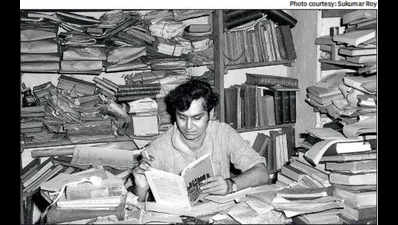- News
- City News
- kolkata News
- The king, not a pawn: Soumitra Chatterjee enjoyed being his own master while writing
Trending
This story is from November 16, 2020
The king, not a pawn: Soumitra Chatterjee enjoyed being his own master while writing
At a time when poets like Sunil Gangopadhyay and Shakti Chattopadhyay represented a genre that took a radical position against accepted norms, Soumitra Chattopadhyay held his own ground that was neither anarchic nor romantic. He was an observer of life. There was subtlety in his writing. There were layers of poignant meanings in his poems that sometimes read almost like prose on the surface but had an underlying rhythm in their non-Tagorean, non-romantic approach. This is how the critics of Soumitra ‘the poet’ admire and sum him up.

For the past 10 years, Soumitra has also been painting a lot and his artworks have received wide acclaim from artists like Jogen Chowdhury, who has even helped to organize an exhibition of Soumitra’s paintings
At a time when poets like Sunil Gangopadhyay and Shakti Chattopadhyay represented a genre that took a radical position against accepted norms, Soumitra Chattopadhyay held his own ground that was neither anarchic nor romantic. He was an observer of life. There was subtlety in his writing. There were layers of poignant meanings in his poems that sometimes read almost like prose on the surface but had an underlying rhythm in their non-Tagorean, non-romantic approach.This is how the critics of Soumitra ‘the poet’ admire and sum him up.
His invaluable contribution to the Bengali literature includes his joint effort with Nirmalya Acharya to publish ‘Ekshan’, a literary magazine. “Ekshan’s handling of social history, women writing in Bengal, long-lost manuscripts and the publication of Noti Binodini’s autobiography are all invaluable contributions of Soumitra-da to literature,” said critic and essayist Shamik Bandyopadhyay, who has also edited the body of Soumitra’s prose collections, the last of which is getting readied now.
Satyajit Ray would design the cover of ‘Ekshan’ and each time there would be a change in the yuktakshar of the name.
Writers feel that it was in his writings that one can see the real Soumitra. “His commitment to Marxist political ideology, his pent-up angst against the prevailing social injustices and the crumbling of the ideals that he believed in and the resultant bitterness came out in a distilled form in his writings. This was his real self, his own thoughts where no one was directing him like it was in his films and theatre,” says Bandyopadhyay.
“In the late ’60s and early ’70s, Soumitra was writing poetry profusely but he was shy and would keep them in his sling bag. It was Shakti Chattopadhyay who would force them out of the bag to read and send for publication,” said Chattopadhyay’s publisher Shuvankar Dey.
For the past 10 years, Soumitra has also been painting a lot and his artworks have received wide acclaim from artists like Jogen Chowdhury, who has even helped to organize an exhibition of Soumitra’s paintings.
In an interview, poet Joy Goswami had asked Soumitra why he chose to write despite being a successful actor. “He told me that while acting, he got under the skin of the character, but when writing, he was his own master,” reminisces Goswami.
His invaluable contribution to the Bengali literature includes his joint effort with Nirmalya Acharya to publish ‘Ekshan’, a literary magazine. “Ekshan’s handling of social history, women writing in Bengal, long-lost manuscripts and the publication of Noti Binodini’s autobiography are all invaluable contributions of Soumitra-da to literature,” said critic and essayist Shamik Bandyopadhyay, who has also edited the body of Soumitra’s prose collections, the last of which is getting readied now.
Satyajit Ray would design the cover of ‘Ekshan’ and each time there would be a change in the yuktakshar of the name.
Writers feel that it was in his writings that one can see the real Soumitra. “His commitment to Marxist political ideology, his pent-up angst against the prevailing social injustices and the crumbling of the ideals that he believed in and the resultant bitterness came out in a distilled form in his writings. This was his real self, his own thoughts where no one was directing him like it was in his films and theatre,” says Bandyopadhyay.
Poets like Shakti Chattopadhyay, Sunil Gangopadhyay, Subhash Mukhopadhyay and Shankha Ghosh have all written about Soumitra’s writings.
“In the late ’60s and early ’70s, Soumitra was writing poetry profusely but he was shy and would keep them in his sling bag. It was Shakti Chattopadhyay who would force them out of the bag to read and send for publication,” said Chattopadhyay’s publisher Shuvankar Dey.
For the past 10 years, Soumitra has also been painting a lot and his artworks have received wide acclaim from artists like Jogen Chowdhury, who has even helped to organize an exhibition of Soumitra’s paintings.
In an interview, poet Joy Goswami had asked Soumitra why he chose to write despite being a successful actor. “He told me that while acting, he got under the skin of the character, but when writing, he was his own master,” reminisces Goswami.
End of Article
FOLLOW US ON SOCIAL MEDIA










